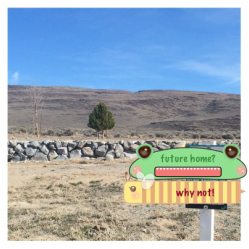Grow Milkweed Plants podcast
Monarch Population 2014 - Episode 003
Monarch population is nearly flat but greatly reduced from previous decades. Pestacides in your garden could be lethal to monarch caterpillars nearby. Interstate 35 is becoming the Monarch highway. Milkweed in my backyard. Where are the monarchs vacationing in Mexico?
Today is Thursday February 18th 2015.
Welcome to Grow Milkweed Plants podcast episode three. I am the host Brad Grimm and thank you for joining me.
I am going to dive right into the numbers and break down how the 2014 count compares to previous years. Beginning with the Western count and then I will focus on the Eastern count that comes from Mexico.
Monarch Joint Venture publishes the stats for the California count. The 2014 population is 235 thousand monarchs. The 235 thousand in 2014 compares to 211 thousand that were counted in 2013. 235 is obviously more than 211 thousand, so that is definitely a good thing. As a percentage of change year over year there was an 11.4 precent increase from 2013 to 14. To play with the statistics a little further I took the 15 year average which is a count of 188k and we see that the current western count is again above average. However in that average I was excluding the incredible population that was in 1997. In a 16 year average when the 1 point 2 million monarchs of 1997 are included in the average the population is 269.6 which means this years population is more than 35 thousand monarchs fewer than the average dating back to the first reported count.
Stepping back from the statistics for a moment and taking look a the big picture of the Western population and what I see is that the population is generally normal. Not really exciting numbers from the West. Except that the normal number is actually drastically lower that where it was in 1996 and 1997. Although we don't have formal records to compare to before 1997 I think its okay to make some assumptions. My first assumption is that the numbers were much higher before we kept records and my second assumption is that something triggered the decline. A decline of over 75 percent over two years is pretty substantial. So now I’m going to point my at a possible cause. I’m not going to go as far as to make the assertion that Roundup Ready crops are the cause but I did find some information to support discussing this further. I found a “Interdisciplinary Minor in Global Sustainability Senior Seminar (Instructor: Peter A. Bowler) University of California, Irvine, March 1998” where the text says that in 1996 an estimated 2 percent of soy bean crops will be roundup ready. And Greenpeace believes it might be as much as 33 percent of the total U.S. soybean production in 1997. So that represents a significant increase in the use of a product that kills insects like monarchs in all phases of their life cycle. The correlation in timing is striking. It seems to me that the increase in RoundUp likely caused an decrease in monarchs and that is troubling. I don’t like to dwell on the past but I think it’s important to understand how past decisions have an impact on our quality of life today. To answer my own question, yes, I think having more monarchs will improve the quality of life for me and everyone.
Moving on to the Eastern population which consists of monarchs that participate in the longest insect migration in North America. The Eastern population travels North in the Spring and South in the Fall. On January 27th Monarch Watch published the Monarch Population Status. I am going to share an excerpt from that report. Here it is: “Nine colonies were located this winter season with a total area of 1.13 hectares. Although this figure represents an improvement from the 0.67 hectares recorded last year, it’s the second lowest population on record and the third low population in as many years. Populations of this size are extremely vulnerable. Winter storms or poor conditions for breeding in the spring and summer could have a severe impact on a population of this size. If there are no winter storms in the next three weeks and conditions are favorable as the monarchs move northward in March to Texas, the long range forecasts suggest that the population has a good chance of increasing again next year.” That update was written by Chip Taylor and a link will be available in the show notes.
So lets break down the numbers from the monarchs which are vacationing in Mexico this last winter.
Chip Taylor said that monarchs were located in 9 sites in Mexico. These sites are all located to the West of Mexico City an centered around El Rosario. Learner dot com has helped me understand a few things about interpreting the count from mexico. The first challenge I had is understanding how much area a Hectare is. A hectare is an area of measurement similar to a US acre. An Hectare is little more than two acres. So 1.3 hectares translates to nearly 2.8 acres. Thats pretty big for one home to be on but really cramped for 57 million butterflies.
Thank you for listening to the episode three of Grow Milkweed Plants. Visit www.growmilkweedplants.com for more information about in this podcast and how milkweed benefits monarchs. On the next episode I will
Today is Thursday February 18th 2015.
Welcome to Grow Milkweed Plants podcast episode three. I am the host Brad Grimm and thank you for joining me.
I am going to dive right into the numbers and break down how the 2014 count compares to previous years. Beginning with the Western count and then I will focus on the Eastern count that comes from Mexico.
Monarch Joint Venture publishes the stats for the California count. The 2014 population is 235 thousand monarchs. The 235 thousand in 2014 compares to 211 thousand that were counted in 2013. 235 is obviously more than 211 thousand, so that is definitely a good thing. As a percentage of change year over year there was an 11.4 precent increase from 2013 to 14. To play with the statistics a little further I took the 15 year average which is a count of 188k and we see that the current western count is again above average. However in that average I was excluding the incredible population that was in 1997. In a 16 year average when the 1 point 2 million monarchs of 1997 are included in the average the population is 269.6 which means this years population is more than 35 thousand monarchs fewer than the average dating back to the first reported count.
Stepping back from the statistics for a moment and taking look a the big picture of the Western population and what I see is that the population is generally normal. Not really exciting numbers from the West. Except that the normal number is actually drastically lower that where it was in 1996 and 1997. Although we don't have formal records to compare to before 1997 I think its okay to make some assumptions. My first assumption is that the numbers were much higher before we kept records and my second assumption is that something triggered the decline. A decline of over 75 percent over two years is pretty substantial. So now I’m going to point my at a possible cause. I’m not going to go as far as to make the assertion that Roundup Ready crops are the cause but I did find some information to support discussing this further. I found a “Interdisciplinary Minor in Global Sustainability Senior Seminar (Instructor: Peter A. Bowler) University of California, Irvine, March 1998” where the text says that in 1996 an estimated 2 percent of soy bean crops will be roundup ready. And Greenpeace believes it might be as much as 33 percent of the total U.S. soybean production in 1997. So that represents a significant increase in the use of a product that kills insects like monarchs in all phases of their life cycle. The correlation in timing is striking. It seems to me that the increase in RoundUp likely caused an decrease in monarchs and that is troubling. I don’t like to dwell on the past but I think it’s important to understand how past decisions have an impact on our quality of life today. To answer my own question, yes, I think having more monarchs will improve the quality of life for me and everyone.
Moving on to the Eastern population which consists of monarchs that participate in the longest insect migration in North America. The Eastern population travels North in the Spring and South in the Fall. On January 27th Monarch Watch published the Monarch Population Status. I am going to share an excerpt from that report. Here it is: “Nine colonies were located this winter season with a total area of 1.13 hectares. Although this figure represents an improvement from the 0.67 hectares recorded last year, it’s the second lowest population on record and the third low population in as many years. Populations of this size are extremely vulnerable. Winter storms or poor conditions for breeding in the spring and summer could have a severe impact on a population of this size. If there are no winter storms in the next three weeks and conditions are favorable as the monarchs move northward in March to Texas, the long range forecasts suggest that the population has a good chance of increasing again next year.” That update was written by Chip Taylor and a link will be available in the show notes.
So lets break down the numbers from the monarchs which are vacationing in Mexico this last winter.
Chip Taylor said that monarchs were located in 9 sites in Mexico. These sites are all located to the West of Mexico City an centered around El Rosario. Learner dot com has helped me understand a few things about interpreting the count from mexico. The first challenge I had is understanding how much area a Hectare is. A hectare is an area of measurement similar to a US acre. An Hectare is little more than two acres. So 1.3 hectares translates to nearly 2.8 acres. Thats pretty big for one home to be on but really cramped for 57 million butterflies.
Thank you for listening to the episode three of Grow Milkweed Plants. Visit www.growmilkweedplants.com for more information about in this podcast and how milkweed benefits monarchs. On the next episode I will
|
Sources:
The Washington Post - http://www.washingtonpost.com/news/energy-environment/wp/2015/02/09/the-monarch-massacre-nearly-a-billion-butterflies-have-vanished/ Western population numbers - http://monarchjointventure.org/news-events/news/western-overwintering-population-2014-15 RoundUp - http://darwin.bio.uci.edu/sustain/global/sensem/burry298.html Monarch Watch Population Status - http://monarchwatch.org/blog/2015/01/27/monarch-population-status-22/ Winter roosting sites in Mexico - http://www.learner.org/jnorth/tm/monarch/PopulationMexicoSites.html |
Be sure to listen to other free episodes of the Grow Milkweed Plants podcast.




